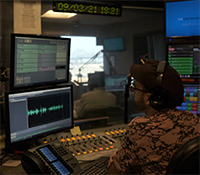Topic: Disaster Relief and Recovery
Posted on 9/14/2021

After Hurricane Ida left most of New Orleans without power, air conditioning and television, Audacy’s WWL AM/FM New Orleans, La., remained on the air and provided a reliable link between their listeners and the outside world. Known among locals as the “hurricane station,” 19 station employees moved into WWL’s studios the day before to ride out the storm and keep the station broadcasting 24 hours a day to cover the aftermath and provide support for residents in need. They slept on air mattresses, relied on a stockpile of snacks and nonperishable food and hosts worked double shifts, all in an effort to provide round-the-clock coverage. The station fielded thousands of calls from listeners with pleas for help, requests for information about loved ones and questions about general information like where to find gas. Many callers were listening in with old battery-powered radios. “This is one of those moments that just so accentuates the immediate intimate relationship between radio and listeners, and we are here for you,” said WWL host Scott “Scoot” Paisant.
Read more stories on Disaster Relief and Recovery »
More than 2.47 million American jobs depend on broadcasting, and the local broadcast radio and television industry - and the businesses that depend on it - generate $1.17 trillion annually for the nation's economy.